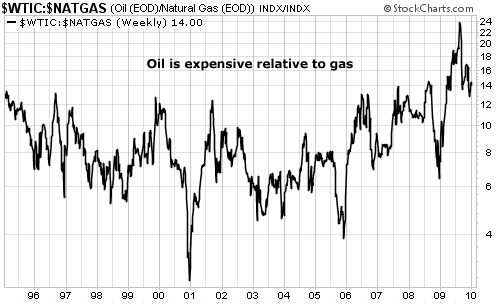 In yesterday's DailyWealth, I outlined how rising interest rates will depress the stock market's P/E multiple... which will create a giant headwind for stock market investors.
In yesterday's DailyWealth, I outlined how rising interest rates will depress the stock market's P/E multiple... which will create a giant headwind for stock market investors.You can protect yourself from this headwind by avoiding high-priced growth stocks. A popular growth stock trading for a P/E of 40 can get cut in half in a matter of months in this kind of environment. For instance, Amazon currently trades for 75 times earnings. Surgical device maker Intuitive Surgical trades for 58 times earnings. Danger ahead.
But what sectors do well when inflation is rising... when the government bond market is correcting... and when earnings multiples in the stock market contract?
Two things in particular: energy and precious metals.
In December 2008, just after witnessing the financial crisis and the government bailout of AIG, the investment banks, and Fannie/Freddie, I knew it was only a matter of time before we entered a market like we have today – one with rising inflation and interest rates. My first – and best advice – was to buy gold bullion.
I also noted how cheap gold stocks were at the time, and recommended buying GDX – the ETF of the unhedged gold producer companies. We bought at $28 per share. It was recently trading at more than $50 per share. I expect it to go much higher, but clearly, our best chance to buy gold stocks is long gone.
On the other hand, various market factors have pushed natural gas down to record low levels – offering us an attractive way to buy a great inflation hedge. It's worth considering what the world's best-managed oil company – ExxonMobil – is doing in this sector right now...
In mid-December of last year, ExxonMobil announced it would buy the largest U.S. natural gas producer, XTO Energy, in an all-stock transaction valued at $41 billion. This will be Exxon's biggest takeover since acquiring Mobil in 1999. The XTO purchase provides Exxon with reserves equivalent to 13.9 trillion cubic feet of gas, or 2.3 billion barrels of oil.
From 2005 to 2008, when most of the other Big Oil companies went on a buying spree, Exxon was selling assets and adding to its massive cash hoard. Just as easy lending led to the real estate crash, high energy prices (especially in natural gas) led oil companies to expand recklessly. They started investing in alternative-energy resources like shale, which cost more to produce.
In December 2005, ConocoPhillips paid $35.6 billion for the independent oil and gas company Burlington Resources. In January 2006, Royal Dutch Shell bought 70,000 acres of the Fayetteville shale property in Arkansas. BP paid nearly $2 billion for 90,000 acres of Chesapeake Energy's Woodford property in July 2008 – right near the top. BP paid another $1.9 billion for a 25% stake in Fayetteville just after the Woodford purchase.
All of these purchases took place while gas was trading near all-time highs. When the economy turned down in mid-2008, natural gas plunged from around $14 per thousand cubic feet (mcf) to less than $3. Big Oil's gas purchases got crushed. That's when Exxon made its move.
The reason Exxon is buying gas is simple... Oil is expensive to find. It's more cost-effective to buy cheap natural gas reserves. Gas has more than doubled from its 2009 low, but it's still down 70% from its 2005 highs.
The chart below shows the 15-year historic ratio of oil to natural gas. When the line peaks, gas is cheap relative to oil. When the line bottoms out, gas is expensive compared to oil. When gas prices bottomed in September 2009, the ratio jumped to more than 24. The current ratio is around 14. While we're not catching the exact bottom, we do have the opportunity to buy gas at one of its cheapest points relative to oil in history.

S&P 500: The stock market has gone to sleep
You can see that natural gas is cheap right now. And three main drivers will increase demand...
1. Domestically, power companies are switching a large number of coal-fired power plants to natural gas. As electricity demand rebounds this year, natural gas demand will rebound faster than expected.
2. In China, coal comprises 70% of the primary energy. Natural gas only makes up 3% of its primary energy. Eventually, out of health concerns for its citizens, China will depend more heavily on the much cleaner alternative – natural gas.
3. Finally, my friend Rick Rule, the hugely successful resource investor, points out that many national oil companies, like Venezuela's and Mexico's, have severely underinvested in their domestic oil production for years. As a result, they will suffer drastic production declines. Unless Iraq steps up its oil production in the next five years, Rick says we'll see "a catastrophic shrinkage in crude export availability." Natural gas can solve that problem, as well.
I predict these three macro factors will push natural gas to more than $10 per mcf this year. Natural gas is under $6 per mcf right now. It's time to be bullish on natural gas.
This post has been republished from Steve Sjuggerud's blog, Daily Wealth.
No comments:
Post a Comment